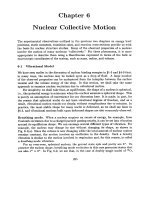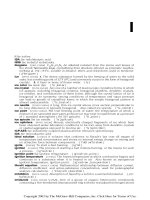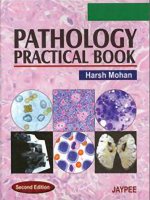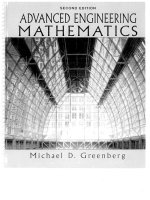Ebook Clinical electrophysiology review (2nd edition): Part 1
Bạn đang xem bản rút gọn của tài liệu. Xem và tải ngay bản đầy đủ của tài liệu tại đây (11.93 MB, 143 trang )
Clinical Electrophysiology
Review
Notice
Medicine is an ever-changing science. As new research and clinical experience
broaden our knowledge, changes in treatment and drug therapy are required. The
authors and the publisher of this work have checked with sources believed to be
reliable in their efforts to provide information that is complete and generally in
accord with the standards accepted at the time of publication. However, in view of
the possibility of human error or changes in medical sciences, neither the authors
nor the publisher nor any other party who has been involved in the preparation or
publication of this work warrants that the information contained herein is in every
respect accurate or complete, and they disclaim all responsibility for any errors
or omissions or for the results obtained from use of the information contained in
this work. Readers are encouraged to confirm the information contained herein
with other sources. For example and in particular, readers are advised to check
the product information sheet included in the package of each drug they plan to
administer to be certain that the information contained in this work is accurate
and that changes have not been made in the recommended dose or in the contraindications for administration. This recommendation is of particular importance in
connection with new or infrequently used drugs.
Clinical Electrophysiology
Review
Second Edition
George J. Klein, MD
Professor of Medicine
University of Western Ontario
London, Ontario, Canada
Eric N. Prystowsky, MD
Director, Electrophysiology Laboratory
St. Vincent Hospital, Indianapolis
St. Vincent Medical Group
Indianapolis, Indiana
Consulting Professor of Medicine
Duke University Medical Center
Durham, North Carolina
New York Chicago San Francisco Lisbon London Madrid Mexico City
Milan New Delhi San Juan Seoul Singapore Sydney Toronto
Copyright © 2013 by McGraw-Hill Education. All rights reserved. Except as permitted under the United States Copyright Act of 1976, no part of this publication may be reproduced or distributed in any form
or by any means, or stored in a database or retrieval system, without the prior written permission of the publisher.
ISBN: 978-0-07-178108-4
MHID: 0-07-178108-0
The material in this eBook also appears in the print version of this title: ISBN: 978-0-07-178106-0,
MHID: 0-07-178106-4.
All trademarks are trademarks of their respective owners. Rather than put a trademark symbol after every occurrence of a trademarked name, we use names in an editorial fashion only, and to the benefit of the
trademark owner, with no intention of infringement of the trademark. Where such designations appear in this book, they have been printed with initial caps.
McGraw-Hill eBooks are available at special quantity discounts to use as premiums and sales promotions, or for use in corporate training programs. To contact a representative please e-mail us at bulksales@
mcgraw-hill.com.
Previous edition copyright © 1997 by McGraw-Hill Education.
TERMS OF USE
This is a copyrighted work and McGraw-Hill Education. (“McGraw-Hill Education”) and its licensors reserve all rights in and to the work. Use of this work is subject to these terms. Except as permitted under the
Copyright Act of 1976 and the right to store and retrieve one copy of the work, you may not decompile, disassemble, reverse engineer, reproduce, modify, create derivative works based upon, transmit, distribute,
disseminate, sell, publish or sublicense the work or any part of it without McGraw-Hill’s prior consent. You may use the work for your own noncommercial and personal use; any other use of the work is strictly
prohibited. Your right to use the work may be terminated if you fail to comply with these terms.
THE WORK IS PROVIDED “AS IS.” McGRAW-HILL AND ITS LICENSORS MAKE NO GUARANTEES OR WARRANTIES AS TO THE ACCURACY, ADEQUACY OR COMPLETENESS OF
OR RESULTS TO BE OBTAINED FROM USING THE WORK, INCLUDING ANY INFORMATION THAT CAN BE ACCESSED THROUGH THE WORK VIA HYPERLINK OR OTHERWISE,
AND EXPRESSLY DISCLAIM ANY WARRANTY, EXPRESS OR IMPLIED, INCLUDING BUT NOT LIMITED TO IMPLIED WARRANTIES OF MERCHANTABILITY OR FITNESS FOR A
PARTICULAR PURPOSE. McGraw-Hill and its licensors do not warrant or guarantee that the functions contained in the work will meet your requirements or that its operation will be uninterrupted or error free.
Neither McGraw-Hill nor its licensors shall be liable to you or anyone else for any inaccuracy, error or omission, regardless of cause, in the work or for any damages resulting therefrom. McGraw-Hill has no
responsibility for the content of any information accessed through the work. Under no circumstances shall McGraw-Hill and/or its licensors be liable for any indirect, incidental, special, punitive, consequential
or similar damages that result from the use of or inability to use the work, even if any of them has been advised of the possibility of such damages. This limitation of liability shall apply to any claim or cause
whatsoever whether such claim or cause arises in contract, tort or otherwise.
To my wife and best friend, Klara.
To my son Ben and daughter-in-law Elissa and their children Adam, Leah, and Beth, and to my
daughter Anna and son-in-law Mark and their daughter Lucy, who are all my real source of pride and joy.
To the memory of my unselfish and giving parents, Paul and Clara.
— George J. Klein
To my wife Bonnie, who is my constant source of love and support.
To my sons David and Daniel, whose lives have filled me with pride and joy, and
to their wives, Malia and Beth, who are the daughters we never had.
And for my grandchildren, Dylan, Laila, Amber, and Noah, in whose presence
the sun always shines and life stands still.
And in loving memory of my parents, Drs Rose and Milton Prystowsky, who taught
me to care for others and that being a physician is not a gift to be wasted.
— Eric N. Prystowsky
This page intentionally left blank
Contents
Preface
ix
Chapter 1
Analysis of Complex Electrophysiologic Data
Chapter 2
Electrophysiologic Approach to the ECG
Chapter 3
Fundamentals of Clinical Electrophysiology
Chapter 4
Narrow QRS Tachycardia
Chapter 5
Wide QRS Complex Tachycardia
Chapter 6
Catheter Ablation
Index
381
297
vii
133
217
1
21
51
This page intentionally left blank
Preface
While new cases have been added and others refreshed, those familiar with the first edition will not see a profound change in emphasis.
Indeed, the electrocardiographic and electrophysiologic problem-solving
skills required to master these arrhythmias have not changed for a long
time and are unlikely to change substantively in the future. There is no
attempt to include every bizarre case that we see or to provide encyclopedic coverage of every issue. Rather, we emphasize an organized approach
based on making observations, “framing” the problem, and testing each
“hypothesis” to explain the observations. We have added several ECG
examples because ultimately the ECG and intracardiac tracings are on
a continuum and require similar approaches and skills. We discourage
a strict pattern recognition approach to the ECG in favor of an electrophysiologic approach.
We hope that this edition will serve you well.
Enormous change has occurred in our specialty since the publication of
the first edition of Clinical Electrophysiology Review. Diverse energy
sources are in development or common use with robotic and magnetic
guidance systems to pinpoint the ablation target. We use sophisticated
mapping systems with anatomically true graphics online and nonfluoroscopic visualization of our catheters. Online intracardiac ultrasound has
become a routine tool in many laboratories. The ablation of atrial fibrillation has become commonplace and is the most common ablation procedure in many laboratories. The ablation of VT has become routine and the
pericardial space is frequently entered to access the epicardium.
Despite this tremendous progress, the need to preserve and indeed
to cultivate our skills in electrocardiographic and electrophysiologic reasoning and diagnosis remains. There is an increasing emphasis on the
technical aspects of electrophysiology in our teaching centers, and generations of young electrophysiologists may not acquire the skills to decipher a complex arrhythmia puzzle. These cases, when they appear, must
be dissected in great detail and the learning points must be thoroughly
examined. It is in this spirit that we have produced the second edition of
this book.
George J. Klein, MD
Eric N. Prystowsky, MD
ix
This page intentionally left blank
Chapter 1
Analysis of Complex
Electrophysiologic Data
approach that does not cut corners. A sample protocol for an unknown
supraventricular tachycardia (SVT) is shown in Table 1–2. When used
routinely, such a protocol will usually result in induction of clinically
relevant tachycardia and provide an assessment of the pertinent EP of
the heart. Determining the functional properties of the atria, ventricles,
and AV conduction system in an individual elucidates the potential
arrhythmia mechanisms and limits the diagnostic possibilities for the
observed arrhythmia. For example, it is difficult to imagine AV reentrant tachycardia occurring in the total absence of retrograde conduction, even realizing the relatively rare occurrence of conduction over
an accessory pathway (AP) only in the presence of isoproterenol. It is
also important to display the data channels in a consistent sequence
to provide an orderly and familiar framework that facilitates analysis.
This point is underscored by the fact that even experienced electrophysiologists require a period of adjustment when looking at data from
other laboratories. Of course, other nonconventional recording sites
can be added to facilitate diagnosis in selected cases. For example,
recording from the left bundle branch can be useful when confirming
the diagnosis of bundle branch reentrant tachycardia.
A thorough diagnostic study need not be time consuming and pays
dividends both intellectually and clinically. The temptation to ablate
an obvious AP without study will not be productive if the patient’s
symptoms are not related to any tachycardia, the patient’s tachycardia
is not related to the pathway, or the “culprit” AP is a different pathway
(Fig. 1–2). The study also provides information regarding other potential rhythm problems that may be unrecognized during the clinical
assessment and allows consideration of alternative approaches such as
slow pathway ablation in a patient with AV reentrant tachycardia that
can only occur with anterograde conduction over the slow AV node
pathway. Radio-frequency ablation itself is an important diagnostic
A novice in a busy electrophysiology (EP) laboratory will generally
learn to recognize the common arrhythmias in a relatively short time.
It requires considerably more seasoning to recognize the variants and
unusual mechanisms, or to “hit the curve ball.” It is hoped that the following commentary assists in providing structure and focus to the EP
study and facilitates analysis of the case studies to follow.
It Begins with the Electrocardiogram
The EP study is an extension of the electrocardiogram (ECG) with the
addition of intracardiac recording and programmed electrical stimulation. Insightful interpretation of the ECG allows for prospectively
considering additional catheters, stimulation sequences, or maneuvers
appropriate for the postulated arrhythmia. This limits the diagnostic
possibilities and avoids unnecessary steps (Fig. 1–1). The fundamentals of ECG interpretation of an arrhythmia include identification of P
waves, determining the atrioventricular (AV) relationship, and analyzing the QRS morphology (Table 1–1). For confusing problems, it is
useful to create a “written” list of all potential hypotheses and to plan
for specific interventions that will test them. As data are accumulated
during the EP study, the facts supporting or refuting the hypotheses can
be tabulated. The hypotheses can be represented by schematic drawings for complicated scenarios. This method is illustrated at the end of
this chapter.
Less Is Often Not More
There are those gifted, intuitive individuals who leap to the correct
diagnosis and apparently bypass all the rational, systematic steps.
Most of us, however, are better served by a consistent, methodical
1
1–1 Two-channel rhythm strip recorded from a patient scheduled for
electrophysiology study for palpitations. The onset of the tachycardia occurs
after the second QRS and the P wave is noted in the following diastole to be
of different morphology than the probable initial sinus P wave. The identification
of the P wave during tachycardia is facilitated by comparison with the last QRS
in the strip that is not followed by a P wave. Careful measurement with calipers
(a critical tool of the electrophysiologist) will illustrate that the onset of the
2
tachycardia does not require PR prolongation. In addition, the cycle length varies
and during this, the PR stays constant while the apparent RP varies. These
findings are most compatible with an atrial tachycardia. Note that most junctional
reentrant tachycardias would require some AV delay at the onset and such
variable retrograde conduction would be unusual. This information provides a
focused starting point to plan electrophysiology study.
CHAPTER 1
tool. Cases involving multiple tachycardia mechanisms can be very
confusing. In such situations, at least one of the tachycardia mechanisms is frequently obvious and successful ablation of the tachycardia
generally simplifies the diagnosis of the remaining mechanism(s).
include the onset of tachycardia, the termination of tachycardia, change
to an alternate QRS morphology, irregularities in cycle length (CL),
and ectopic cycles (Table 1–3). The onset reveals the conditions necessary to initiate the tachycardia. Does it require block in an AP, critical
prolongation of the atrio-His (AH) interval, or conduction delay in the
His–Purkinje system? Does a SVT consistently terminate spontaneously with an atrial electrogram? The latter strongly suggests that the
tachycardia mechanism obligates AV node conduction. Does a change
from normal QRS to bundle branch block alter any of the conduction
intervals or tachycardia CL, suggesting the bundle branch is a critical
component of the tachycardia circuit? Careful attention to the zones of
transition is often rewarding as is illustrated.
The Key Is Frequently at a Transition
Make Something Happen
Fishermen have long appreciated that the majority of the fish are
caught in a relatively small area of the lake. Similarly, the correct diagnosis may not be apparent from the copious EP records during stable
tachycardia. Although the electrograms may have a certain temporal
sequence, there is no indication of cause and effect in the sequence
of electrograms. Is the atrium driving the ventricle or vice versa? Is
the preexcited QRS an active participant in the tachycardia circuit or
merely a bystander camouflaging another mechanism? The “hot spots”
that frequently yield the answer are the zones of transition. The zones
The EP study provides an opportunity to disturb an arrhythmia with
pacing, extrastimuli, autonomic maneuvers, physical maneuvers, and
drugs. Single, or multiple, atrial or ventricular extrastimuli are programmed into the cardiac cycle and made progressively more premature to loss of capture. This invariably provides the zone of transition
that clarifies the requirement of atrium or ventricle in the mechanism
or alters the tachycardia in a manner that clarifies the problem. In other
words, if the tachycardia mechanism is not perfectly obvious, overdrive
pacing or programming extrastimuli will almost invariably clarify it. A
long-standing “inverse rule” may be useful to trainees—initially introduce premature atrial extrasystoles into a wide QRS tachycardia and
ventricular extrasystoles into a narrow QRS tachycardia. Changes in
posture cause autonomic adjustments and alter cardiac filling. Agents
such as adenosine usually affect specific tissues and mechanisms, and
can be invaluable. Isoproterenol is useful for mimicking states of catecholamine excess or altering specific EP properties to allow induction
of tachycardia.
Although many pacing and extrastimulation maneuvers have been
described, it is useful to understand the basic underlying principles by
which they function. The overriding principle underpinning most pacing interventions is illustrated schematically in Fig. 1–3. In essence,
the ability of pacing to influence or “reset” a tachycardia is dependent
on two key variables.
Table 1–1 ECG Rhythm Analysis
•
•
•
•
Identify P waves and determine their morphology, if possible
Determine the atrial rhythm
Analyze the QRS complex morphology
Determine the A–V relationship
Table 1–2 Sample Protocol for Supraventricular Tachycardia
• Record five surface ECG leads
• Insert four intracardiac catheters to record from the high
right atrium (HRA), His bundle (H), right ventricle (RV),
and coronary sinus (CS)
• Incremental atrial and ventricular pacing to AV and VA block,
respectively
• Atrial and ventricular extrastimulus testing at two or more basic
drive cycle lengths
• Use multiple extrastimuli, atrial, and ventricular pacing,
pharmaceuticals (e.g., adenosine, isoproterenol, verapamil), as required
ANALYSIS OF COMPLEX ELECTROPHYSIOLOGIC DATA
3
1–2 Tracing from a patient with Wolff–Parkinson–White (WPW) and
documented supraventricular tachycardia. The first two cycles are preexcited and
a 12-lead ECG suggested a septal pathway conducting anterogradely. Earliest
ventricular activation in sinus rhythm is at the proximal coronary sinus electrode
(CSp) positioned near the orifice of the coronary sinus. An atrial extrastimulus
(S) blocks the pathway and starts supraventricular tachycardia. However, earliest
4
retrograde atrial activity is at the distal coronary sinus electrogram. In this
patient, complete mapping revealed that the “culprit” accessory pathway was a
concealed left lateral pathway and the manifest accessory pathway was of no
clinical significance. Ablation of this pathway would have served no purpose.
1, 2, and V1, surface ECG; HBE, His bundle electrogram.
CHAPTER 1
1–3 Schematic illustration of dependence of pacing intervention on distance
and access to the tachycardia mechanism. (A) The pacing cannot conduct to
the tachycardia circuit. An example would be ventricular pacing with an atrial
tachycardia in the absence of ventriculoatrial conduction. (B) The paced impulse
is close to and has excellent access to the tachycardia mechanism. An example
might be right ventricular basal pacing in AV reentrant tachycardia over a right
accessory pathway. You would expect the tachycardia to be easily reset by
pacing at relatively long coupling intervals and you would expect also the VA
interval during tachycardia to approximate the stimulus to A interval during
pacing. You would also expect the postpacing interval (PPI) to be close to the
tachycardia cycle length. (C) The pacing site is relatively far from the circuit and
the circuit is relatively small. The usual example would be RV pacing during AV
node reentrant tachycardia. You would expect that it would be difficult to reset this
tachycardia and only with short coupling intervals. In addition, you would expect
the VA interval during tachycardia to be considerably longer than the stimulus to
A interval during pacing. You would also expect the PPI to be considerably longer
than the tachycardia cycle length.
ANALYSIS OF COMPLEX ELECTROPHYSIOLOGIC DATA
5
Table 1–3 Zones of Transition: The Key to the Mechanism
•
•
•
•
•
The onset and termination of tachycardia
Change to an alternate QRS morphology
Irregularities in cycle length
Ectopic cycles
The onset and termination of overdrive pacing
The first is distance from the pacing site to the tachycardia mechanism. (Note that this distance may also be “electrophysiologic” as well
as geographic in that the pacing site may be “far” from the tachycardia
mechanism if there is conduction block adjacent to pacing site requiring a roundabout access to the mechanism.)
The second is access to the circuit. A large reentrant circuit with
a large excitable gap is more penetrable by pacing than a “focal”
arrhythmia source. In essence, preexcitation of the subsequent A by a
premature ventricular complex (PVC) during SVT occurs much more
readily with a large AV reentrant circuit close to the pacing site rather
than the much smaller and most distant circuit of AV node reentry.
Similarly, capture of a SVT by ventricular pacing also depends on the
same factors. The postpacing interval (PPI) and the difference of ventriculoatrial (VA) during tachycardia compared with VA during pacing
clearly depend on these. In fact, the PVC that resets the A during SVT
is just capture for one cycle and all the useful postpacing data also
apply to the single PVC that resets tachycardia as will become evident
in some of the exercises.
Expect the Unexpected
It is important to keep an open mind to all the diagnostic possibilities
until the correct one has been clearly established. Prematurely accepting what appears to be obvious may result in the psychological trap of
fitting subsequent observations to the expected and may blind a person
from performing the required steps. For example, a SVT with simultaneous atrial and ventricular activation immediately suggests AV node
reentry but does not rule out atrial tachycardia with a long AV interval
or junctional tachycardia with retrograde conduction.
6
You Must Have the Tools
An organized approach and a strategic plan are only useful with a firm
knowledge of physiologic principles and mechanisms. Consider an
example where ventricular pacing produces a “central” (concentric)
retrograde activation sequence with earliest retrograde atrial activation
at the His bundle electrogram. Retrograde conduction time is constant
(not rate dependent), and there is no suggestion of anterograde preexcitation. Is retrograde conduction proceeding over the AV node, or
is it proceeding over a “concealed” septal AP? Block of retrograde
conduction with adenosine favors but does not definitively prove AV
node conduction since adenosine may affect some APs. A fundamental
physiologic principle can be applied. The VA conduction will be shortest when pacing at the ventricular site closest to the retrograde pathway. In the case of an anteroseptal AP, pacing the ventricle near the His
bundle will provide the shortest VA interval (assuming one does not
use sufficient energy to cause His bundle capture). In the case of AV
node conduction, pacing near the terminus of the right bundle branch
(the RV apex is close to this) will provide the shorter VA interval when
pacing at the same rate. This principle is illustrated in Fig. 1–4. Pacing
the His bundle directly will result in very early capture of the atrium
near the His bundle. Loss of His bundle capture (by lowering current
strength) and retaining capture of myocardium in the region will result
in no change in VA interval if retrograde conduction was proceeding
over an anteroseptal AP but will result in VA prolongation if conduction was proceeding over the AV node or a more distant AP.
As another example, AV node conduction is rate dependent (decremental) with prolongation of the AH interval after progressively more
premature atrial extrastimuli, while AP conduction is generally not rate
dependent. However, it is important to appreciate that some APs exhibit
impressive rate dependence comparable to the AV node, whereas other
AV nodes exhibit little or no rate dependence and mimic AP conduction. There is no shortcut to the assimilation of EP principles.
A differential diagnosis of potential entities when a phenomenon
is encountered is a fundamental tool to begin the process of hypothesis
testing to arrive at the correct diagnosis. Tables 1–4 to 1–12 may be
useful in this regard in the analysis of the unknown traces providing
the possible mechanisms under each category of observation.
CHAPTER 1
1–4 Evaluation of retrograde conduction during EP testing, “para-Hisian
pacing.” This patient had concentric retrograde atrial conduction that was
rate independent (not “decremental”) and it was unclear whether retrograde
conduction was proceeding over the normal AV node or over a concealed septal
accessory pathway. “Para-Hisian” pacing is started by pacing the distal pole of
the His catheter with the electrogram at the site showing a clear His deflection
and relatively small A so as not to pace the A inadvertently. Right ventricular
paraseptal pacing has been achieved because the HBd catheter shows local
capture. His bundle pacing is achieved (first three cycles) as suggested by
the relatively narrow QRS (in fact, fusion between RV pacing and His pacing).
Noticeably, atrial capture is not present since the stimulus to A at the atrial
ANALYSIS OF COMPLEX ELECTROPHYSIOLOGIC DATA
septum is longer than you would expect if such were the case. As the current
strength is reduced, His bundle capture is lost and the adjacent RV myocardium
is still paced. This is indicated by the widening of the QRS (asterisk ) and the
appearance of a retrograde His potential (arrow ). This clearly indicates that
retrograde conduction was proceeding over the AV node since conduction over
an anteroseptal AP would not be affected by the loss of His bundle capture. A,
atrial electrogram; CS, coronary sinus electrograms from proximal (3) to distal
(1), respectively; HB, His bundle electrograms from the distal (d) and proximal
(p) poles of the catheter; RA and RV, right atrial and ventricular electrograms,
respectively; V, ventricular electrogram.
7
1–5 Tracing from patient described in the section “example A” (see text). H, His
bundle electrogram; RB, right bundle branch electrogram.
8
CHAPTER 1
1–6 Second tracing from patient described in the section “example A” (see text).
ANALYSIS OF COMPLEX ELECTROPHYSIOLOGIC DATA
9
1–7 ECG during tachycardia from patient in the section “example B” (see text).
10
CHAPTER 1
1–8 ECG during sinus rhythm from patient in the section “example B” (see text).
ANALYSIS OF COMPLEX ELECTROPHYSIOLOGIC DATA
11
1–9 Induction of tachycardia in patient from the section “example B.” The
arrow indicates retrograde activation of the His bundle. HV, His–ventricular
interval; S1, last paced cycle of drive; S2 and S3, extrastimuli.
12
CHAPTER 1
1–10 Spontaneous termination of tachycardia in patient from the section
“example B.”
ANALYSIS OF COMPLEX ELECTROPHYSIOLOGIC DATA
13
Table 1–4 Differential Diagnosis of Wide QRS Tachycardia
•
•
•
•
•
SVT with aberrancy
VT
Preexcited tachycardia
Consider artifact (pseudotachycardia)
Consider ventricular pacing
Table 1–5 Differential Diagnosis of Narrow QRS Tachycardia
•
•
•
•
•
Atrial tachycardia
AV node reentry
AV reentry
Junctional tachycardia
VT (fascicular tachycardia, “septal” VT can mimic SVT)
The Electrophysiology Study:
An Application of Hypothesis Testing
An orderly EP study is an exercise in establishing a differential diagnosis and systematically gathering evidence to arrive at the correct one.
Analysis of an unknown tracing is easier in the context of a real study
where one has the advantage of building on information and applying
interventions to assist the process. Nonetheless, the exercise of interpreting an unknown trace out of context is an effective learning tool.
Review of an unknown EP record is fundamentally the same as reading
an ECG with the advantage (and challenge) of the intracardiac recordings. An approach to this analysis is outlined in Table 1–12 and is illustrated in the following examples.
It is useful to “frame the problem” explicitly before detailed analysis. For example, if one decides from the analysis of the tracing that
a tachycardia is present with no H recording when the His catheter is
appropriately positioned, there are only two possibilities to consider
as per Table 1–8. The tables presented provide “frames” that can be
used to organize the search for the correct mechanism. During a multiple choice examination, the “frame” is provided by the choices of the
examiner.
14
1–11 (A) Schematic representation of bundle branch reentry. (B) Intramyocardial
reentry with passive activation of bundle branches. See text.
CHAPTER 1









